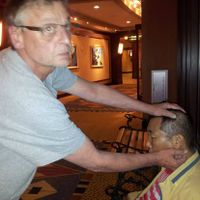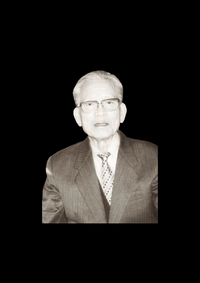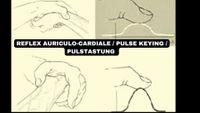Ear Acupuncture
I have decided to use my 40 years of knowledge of Acupuncture to dedicate this textbook to my little daughter, Angelic.
Ich habe mich entschlossen mein 40-jähriges Wissen über Akupunktur zu nutzen, um dieses Lehrbuch meiner kleinen Tochter Angelic zu widmen.
I first learned acupuncture from Grandmaster Han-Young Choi, and he learned from Grand Patriarch Dr. Chang In Mok, in the 1940s in acupuncture.
In 1980, Han-young Choi asked his friend Professor Dr. Lee, who was a Taekwondo Grandmaster and 9th Dan holder and taught Acupuncture and Traditional Chinese medicine (TCM) at the University of California, encouraged me to continue my education in Traditional Chinese Medicine. He first taught me different types of body Acupuncture.
At that time, acupuncture was not recognized by science and general medicine, the diagnostic procedures and treatment phases for correct successful application and acupuncture was banned from medicine!
What is Acupuncture, and how does Acupuncture work?
Acupuncture is by no means to be regarded as a holistic, independent method in medicine. Acupuncture is used in TCM for about 30% to relieve pain, diagnose diseases and to heal.
In contrast to body Acupuncture, ear Acupuncture is easy for the therapist to understand, but excludes many diagnostic options and treatment methods.
After 10 years of experience with many patients, I switched to ear acupuncture and have experienced that treatment times in Orthopaedics are three times shorter.
Here are two reasons:
1. Body acupuncture is sometimes painful
2. You need the right timing, and you also need to be able to calculate when the meridian (TCM) in the brain is active, otherwise, the treatments will have no effect and will not be successful!
The major advantage of ear acupuncture is
1. not painful
2. Effect imminent
Our skin is a map. And if you want to understand, you have to learn this card first.
It should be noted that each person is an individual and has their own map. That depends on how we grow in our mother's womb during pregnancy.
In our ear, you will also find a complete map of the body. If you follow the earlobes, you will see that they are the same shape as our head.
We need to diagnose two types of points:
1. visible points
- not to explain, your eyes see it
2. invisible points
- look at the pain- or Pressure Points or
- You have to use pulse key to find the point
This requires a pulse key
When a mosquito gets too close to our eye, we automatically protect ourselves and through an innate (evolutionary) reflex, we automatically close our eyelids. When stimuli hit our body, how.
Light, touch, or loud noises trigger this reflex, which causes the blood vessels in the fingers and carotid artery to constrict.
This contraction causes a minimal backflow of blood in our arteries. The return current is superimposed on the pulse wave coming from the heart and is thereby amplified. This pulse amplification can be felt on the wrist and neck.
We can use these innate reactions and find the right acupuncture points. Allergies, toxic loads, but also the right medication can be tested in this way. With this test method, I can evaluate the gene structure and thus determine intolerance or tolerance.
You can test, for example, whether a person has absorbed pollutants (Palladium through catalyst exhaust gases) through environmental influences, whether he tolerates silver or gold. What lifestyles make him ill, and what food he needs for himself individually?
What vitamins does the body lack? How does our body process toxins?
It depends on our ancestors and our genes whether we are immune to toxins or whether they burden us. if, e.g. For example, if our ancestors had a long tradition of smoking, we are most likely resistant to the toxin nicotine.
Didn't our ancestors smoke, to be sure, that means suffering, illness, and ultimately death!
Ich lernte Akupunktur zuerst von Großmeister Han-Young Choi und er lernte von Großpatriarch Dr. Chang In Mok, in den 1940er-Akupunktur.
1980 bat Han-young Choi seinen Freund Professor Dr. Lee, der Taekwondo-Großmeister war und Inhaber des 9. Dan war und an der Universität in Kalifornien Akupunktur und traditionelle Medizin unterrichtete, mich in der Traditionellen chinesischen Medizin (TCM) weiterzubilden. Er lehrte mich zuerst verschiedene Arten der Körperakupunktur.
Zu dieser Zeit wurde die Akupunktur von der Wissenschaft und Allgemeinmedizin, die Diagnoseverfahren und Behandlungsphasen zur richtigen erfolgreichen Anwendung nicht anerkannt und Akupunktur wurde aus der Medizin verbannt!
Was ist nun Akupunktur und wie wirkt die Akupunktur?
Die Akupunktur ist auf keinen Fall als ganzheitliche, eigenständige Methode in der Medizin anzusehen. Akupunktur wird in der TCM etwa zu 30 % angewendet, um Schmerzen zu lindern, Krankheiten zu diagnostizieren und um zu heilen.
Im Gegensatz zur Körperakupunktur ist die Ohrakupunktur für den Therapeuten leicht verständlich, grenzt aber viele Diagnosemöglichkeiten und Behandlungsmethoden aus.
Nach 10 Jahren Erfahrung mit vielen Patienten bin ich zur Ohrakupunktur gewechselt und habe damit die Erfahrung gemacht, dass sich die Behandlungszeiten in der Orthopädie sich um das 3-fache verkürzen.
Hier Zwei Gründe:
1. Körperakupunktur ist manchmal schmerzhaft
2. Du brauchst das richtige Timing und musst es auch berechnen können, zu welcher Zeit der Meridian (TCM) im Gehirn aktiv ist, sonst haben die Behandlungen keine Wirkung und Erfolg!
Der große Vorteil der Ohrakupunktur ist
1. nicht schmerzhaft
2. Wirkung unmittelbar bevorstehend
Unsere Haut ist eine Karte. Und wenn Du verstehen möchtest, musst Du diese Karte zuerst lernen.
Zu beachten ist, dass jeder Mensch ein Individuum ist und er hat auch seine eigene Landkarte. Das hängt davon ab, wie wir während der Schwangerschaft im Bauch unserer Mutter herangewachsen sind.
In unserem Ohr findest Du also eine vollständige Karte des Körpers. Wenn Du Dir die Ohrläppchen ansiehst, wirst Du erkennen, dass sie die gleiche Form wie unser Kopf haben
Wir müssen zwei Arten von Punkten diagnostizieren:
1. sichtbare Punkte
- nicht zu erklären, Deine Augen sehen es
2. unsichtbare Punkte werden durch
- Druck- und Schmerzpunkte oder
- durch die Pulstastung ermittel
Dazu benötigt es einer Pulstastung
Wenn eine Mücke unserem Auge zu nahe kommt, schützen wir uns automatisch und schließen durch einen angeborenen (evolutionären) Reflex automatisch unsere Augenlider.
Wenn Reize auf unseren Körper treffen, wie. Licht, Berührung oder laute Geräusche, wird dieser Reflex ausgelöst, der zur Verengung der Blutgefäße im Bereich der Finger und Halsschlagader führt.
Dies sich Zusammenziehen bewirkt einen minimalen Blutrückstrom in unserer Schlagader. Der Rückstrom überlagert sich mit der vom Herzen kommenden Pulswelle und wird dadurch verstärkt. Diese Puls Verstärkung ist am Handgelenk und Hals tastbar.
Diese angeborenen Reaktionen können wir nutzen und die richtigen Akupunkturpunkte finden. Allergien, toxische Belastungen, aber auch die richtigen Medikamente können so ausgetestet werden. Mit dieser Testmethode kann ich die Genstruktur auswerten und damit die Unverträglichkeit oder Verträglichkeit feststellen.
Du kannst z.B. austesten, ob ein Mensch Schadstoffe ( Palladium durch Katalysator Abgase ), durch Umwelteinflüsse aufgenommen hat, ob er Silber oder Gold verträgt. Welche Lebensweisen ihn krank machen und welche Nahrung er für sich individuell braucht.
Welche Vitamine fehlen dem Körper? Wie verarbeitet unser Körper die Giftstoffe?
Es hängt von unseren Vorfahren und unseren Erbanlagen und Gene ab, ob wir unempfindlich gegen Giftstoffe sind oder ob sie uns belasten. Wenn z. B. unsere Vorfahren eine lange Tradition des Rauchens hatten, sind wir höchstwahrscheinlich resistent für den Giftstoff Nikotin. Haben unsere Vorfahren nicht geraucht, sei gewiss, das bedeutet, Leiden, Krankheit, letztendlich der Tod!
be continued soon



